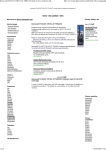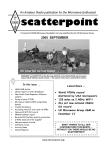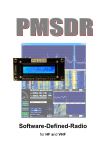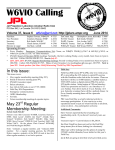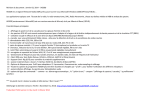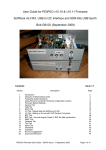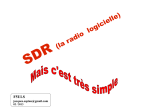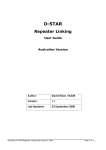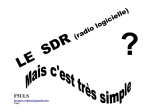Download W6IFE Newsletter July 2008 Edition REMINDER
Transcript
W6IFE Newsletter July 2008 Edition President John Oppen KJ6HZ 4705 Ninth St Riverside, CA 92501 [email protected]. Vice President Jeff Fort Kn6VR 10245 White Road Phelan CA 92371 909-994-2232 [email protected] Recording Sec Maurice Gresson K6ynh 6752 Gardenia Ave Long Beach CA 90805 562-422-3301 [email protected] Corresponding Sec Kurt Geitner, K6RRA1077 E Pacific Coast Hwy TMB142 Seal Beach, CA 90740 310-718-4910 [email protected] Treasurer Dick Kolbly, K6HIJ 26335 Community Barstow, CA 92311 760-253-2477 [email protected] Editor Bill Burns, WA6QYR 247 Rebel Rd Ridgecrest, CA 93555 760-375-8566 [email protected] Webmaster Dave Glawson, WA6CGR now in new location [email protected] ARRL Interface Frank Kelly, WB6CWN PO Box 1246, Thousand Oaks, CA 91358 805 558-6199 [email protected] W6IFE License Trustee Ed Munn, W6OYJ 6255 Radcliffe Dr. San Diego, CA 92122 858-453-4563 [email protected]. At the 3 July 2008 SBMS meeting the "Tech Talk" topic is "10 Band Rover Rig" presented by N6NB, Wayne Overbeck. The SBMS meets at the American Legion Hall 1024 Main Street (south of the 91 freeway) in Corona, CA at 1900 hours local time on the first Thursday of each month. Check out the SBMS web site at http://www.hamradio.com/sbms/. REMINDER- NO PARKING IN THE CHURCH LOT Last meeting-Prentiss Robinson, N6VVG gave us a presentation on classic digital processing. Mrs. Robinson, WB6CKL was also with us. Pat, N6RMJ indicated that all clubs need to get their 2 GHz and Up logs in before the end of the month. MUD2008 articles need to be in by August 31. SBMS will be guiding MUD 2010 in the same area as 2005. Daniel Watford, M0EBK from Fullerton was a visitor as was our ARRL Division Chairman Dick Norton N6AA. Doug, K6JEY indicated there would be a star party at OVRO the third week in July. 32 people present Scheduling. Hello Microwavers This is a quick note to let every body know that the SBMS Microwave tune up Picnic will be held one week later this year. The date is August 2, 2008; this is the first Saturday one week after TRW. The location will be the same as last year Fairview Park in Coasta Mesa.2525 Placentia Avenue, Costa Mesa, 92626. Any questions you can call or e-Mail me. 714 529-2800 73Dick WB6DNX 2-3 Aug ARRL UHF contest 16-17 August ARRL 10 GHz and Up contest 13-15 September ARRL Sept VHF QSO Party 20-21 September ARRL 10 GHz and Up contest second half 20-21 September ARRL International EME Competition 18-19 October ARRL International EME Competition 15-16 November ARRL International EME Competition “Wants and Gots for sale”. For Sale Boonton 102A signal generator –120 to +10 dBm 520 MHz to 4.2 GHz am/fm Dick WB6DNX 714-5292800 Want 118 to 136 aircraft band scanner Dick, K6HIJ 760-253-5127/2977 Want service manual for Motorola R-2001A communications analyzer Dan W6DFW [email protected] Want linear actuator from TVRO dish. 24” stroke preferred but any considered. John KJ6HZ [email protected] 951288-1207 For Sale- Halicrafters S-120 SWL receiver and manual $25. Bill WA6QYR [email protected] 760-375-8566. Free to a good home 2ft Pcom style dish with mounting, pickup only at Huntington Beach Wayne KH6WZ 310-3574761 [email protected]. Activity reported at the June meeting-Dick, WB6DNX repackaged his Endwave 24 GHz rig; Chuck, WA6EXV built some beacon 24 GHz antennas and measured them on his range using the Endwave 24 GHz parts; Bill WA6QYR made some copies of the 1957 handbook for English ham; Doug, K6JEY has a new" service monitor HP8924C and a 1 KW ac generator; Jerry N7EME redesigned his oscillators for better performance; Jeff KN6VR did some work connecting his 10 MHz oscillator to his DB6NT rig and worked with his 1 mtr dish; Wayne, N6NB worked the 2 GHz and up on 4 bands; Maurice, K6YNH did some tripod work; Bill, N6MN got on 10 GHz and made 2 contacts for his first microwave contacts; Wayne, KH6WZ made some progress on his Endwave 24 GHz rig with a new power supply; Don, KF6QWB did some work on his digital radio; Mel, WB6JBD worked on some software rf propagation prediction; Chris, N9RIN put his Endwave 24 GHz rig on a PCOM chassis so to use the 2 ft dish and did some 10 GHz repairs; Peter, K6PTL worked on his 10 GHz rig; Ed KE6FJU worked on his 1.7 GHz weather antennas; Michelle, W5NYV is working on ground station hardware for AMSAT 5 GHz up and 3.7 GHz down; Paul KB5MU is working on kits for AMSAT; Joonho, KG6MQS has his Endwave 24 GHz rig working great; Pat, N6RMJ had hardware problems during the 2 GHz contest; dick, K6HIJ has a prototype 3456 MHz kit working and has TVRO front end stuff for free; Larry, K6HLH has his 10 GHz rig working again; Walter had some phenomenology hard ware to show; Tom, WB6UZZ worked on an ATV antenna; ATV had a number of check ins. ---- Original message ---Date: Fri, 23 May 2008 21:50:48 -0700 From: "Gary (ad6fp)" <[email protected]> Subject: [Mw] W6QI SK To: [email protected], [email protected], [email protected] It is with the deepest sadness that I have to tell you of the death of Frank Bauregger, W6QI. Frank was a first class microwave operator as well as a top-notch engineer. I have many fond memories of working microwaves from California mountaintops with Frank. He was always willing to help others with technical problems and was able to come up with brilliant solutions to the most difficult problems. Frank gave many talks to local ham radio clubs that were always very entertaining as well as highly educational. He will be greatly missed by the microwave community. Frank pursued his interests with great passion, skill and enthusiasm. He was a skilled guitar musician and most recently became interested in modifying his Mustang for drag racing. Frank accomplished much during his life; the web pages below document some of his achievements in his own words:http://waas.stanford.edu/~wwu/frankb/ I'm proud to say that Frank was a friend and I will miss him very much. I'm really sorry to hear the news. It's unfortunate to see him go at such a young age. He had so much more ahead of him and was a mentor and great friend to many of us. W6BY ATV Guide from Newsletter by Bryon Foster Scheduled Program Guide for ATV Monday: SCART Net (GB3IV) http://g7jtt.camstreams.com Tuesday: ATCO ATV Net Every Tuesday at 6:00 PM PT/9:00 PM ET http://wb8lga.camstreams.com W7TED Repeaters Net Night Every Tuesday at 8:00 PM PT/11:00 PM ET http://w7ted.camstreams.com Torbay Amateur Television & Microwave Group Every Tuesday at 2000 to 2200 UTC/1:00 PM PT/4:00 PM ETor www.gb3tb.dyndns.tv http://www.ustream.tv/channel/gb3tb-23cms-atv-repeater ATN-CA Net Every Tuesday at 8:00 PM PT/11:00 PM ET www.ac6rb.com then click on option #1 or #2 Backup Streaming Video Address for the Net http://ustream.tv/channel/n6gkb via Snow Peak Repeater Wednesday: Chat Night, GB3ZZ Every Wednesday at 2100 UTC/1:00 PM PT/4:00 PM ET http://gb3zz.camstreams.com CATS Net Every Wednesday at 6:00 PM PT/9:00 PM ET http://kb3lnn.camstreams.com Thursday: Torbay Amateur Television & Microwave Group Group Activity Night Every Thursday at 2000 to 2200 UTC/1:00 PM PT/4:00 PM ET http://www.ustream.tv/channel/gb3tb-23cms-atv-repeater or www.gb3tb.dyndns.tv San Bernardino Microwave Society Meeting Next meeting July 3rd www.ac6rb.com then click on option #1 or #2 BRATS Net Every Thursday at 6:00 PM PT/9:00 PM ET http://kb3lnn.camstreams.com Friday:GB3GG, Grimsby Amateur Television Group Net Every Friday at 2100 ZULU 2:00 PM PT/5:00 PM ET http://www.ustream.tv/channel/gb3gg Sunday: Coffee Klatch Every Sunday at 9:00 AM PT/12:00 Noon ETwww.ac6rb.com then click on option #1 or #2 International ATV Net Every Sunday at 12:00 Noon PT/3:00 PM ET http://kb3lnn.camstreams.com Torbay Amateur Television & Microwave Group Activity Night Every Sunday at 2000 to 2200 UTC/1:00 PM PT/4:00 PM ET http://www.ustream.tv/channel/gb3tb-23cms-atv-repeater or www.gb3tb.dyndns.tv MATS Net Every Sunday at 5:00 PM PT/8:00 PM ET http://kb3lnn.camstreams.com ATV DXing KA9UVY http://ka9uvy.camstreams.com Bob is active mostly morning during weekdays And all hours weekends. Hepburn tropo forecast page:http://www.dxinfocenter.com/tropo.html ATV DXers post their CQ's and Reports to the ATV logger page:http://dxworld.com/atvlog.html Hawaiian Beacons for the West Coast provided by. "KH6HME" 144.170 MHz 432.075 MHz 1296.34 MHz Other Streaming ATV Videos K8DMR's Cam stream http://k8dmr.camstreams.com WB8LGA's Cam stream Links to other cam streams and Google ATV Maps and location to view the ATCO ATV Net http://wb8lga.camstreams.com Severnside Television Grouphttp://www.camsecure.co.uk/Camsecure_Radio_Amateurs.html N6GKB's Tower Cam in Yucca Valley, CA and back-up for the AC6RB streaming videos for the ATN. http://ustream.tv/channel/n6gkb If you have a scheduled Net or Event on your Streaming Video that you would like listed in the "ATV Guide" please send your information to: [email protected] ___________________________________ ATV WEBSITE GUIDE __________________________________ Acres Electronics, ZL4TAO ATV Gear www.acreselectronics.co.nz Amateur Radio Victoria www.users.amateurradio.com.au Amateur Radio Victoria/VK3FCE www.amateurradio.com.au/vk3fce Associated Radio Amateurs of Long Beach, Inc. Club Station located on "Queen Mary" W6RO http://www.aralb.org ATCO Newsletter www.atco.tv Amateur Television Network www.atn-tv.org Amateur Television Quarterly http://www.hampubs.com ATV Newsletter (Back Issues Only) http://www.qsl.net/g3zhi/atvnews.htm Baltimore Radio Amateur Television Society (BRATS) http://www.bratsatv.org British Amateur Television Club Forums http://www.g1fef.co.uk/forums British Amateur Television Club Website (BATC) http://batc.org.uk Chesapeake Amateur Television Society (CATS) http://mysite.verizon/vzev3ql6/id.html CQ-TV Magazine, view back issues and the place to subscribe www.cq-tv.com DATV/Digital Amateur Television Primer, G7LWT And another location you can download bask issues of the "ATV Newsletter" www.g7lwt.com Dutch Digital Amateur Television Site http://d-atv.com G3ZHI Many Ham Radio Links http://www.qsl.net/g3zhi GB3BH http://gb3bh.com GB3KM http://myspace.freeserve.com GW6BWX's Amateur Television Electronics Projects ATV/DATV http://www.atv-projects.com/index.html Hamoholics, 2E0GYZ www.2e0gyz.ning.com Intuitive Circuits, LLC ATV Repeater Controllers http://www.icircuits.com/prod_atv_main.html On-Screen ID Overlay and home page http://www.icircuits.com K6BEN-ATV http://www.batnet.com/~mfwright.mfwright/k6ben.html Las Vegas Radio Amateur Club http://www.larac.org and www.hxo.com Microwave Experimenters Television System (METS) http://qsl.net/kc6ccc/ Mini-kits Hi-Tech RF Kits and Components http://www.minikits.com.au MNFAT Minnesota Group/KB0OZN www.Mnfat.net N6HOG's Weather Web http://n6hog.com San Bernardino Microwave Society (SBMS) http://www.ham-radio.com/sbms Severnside Television Group http://www.camsecure.co.uk/Camsecure_Radio_Amateurs.html Southgate Amateur Radio Club www.southgatearc.org WA6NUT's page HF with FFT-TV http://www.hamsdr.com/personaldirectory.aspx?did=1139 World Wide ATV Open House October 25, 2008 For more info or to list your Repeater or Individual web stream. [email protected] Article in June 17, 2008 Newsletter Ham Radio Club Newsletter wants info on ATV I received an email a Ham Radio Club requesting frequencies for ATV that are in use here in Southern California for their Newsletter. I printed some of this info in the ATV Newsletter back in early March but with all the new ATVers in So Cal I felt it was worth publishing again. I should point out that there are no membership dues charged for use of the METS ATV Repeaters. I know some of the ATVers on METS and I am sure some of you know them as well. Here is a list of METS I know so far: KC6UQH Art who used to take care of the Palomar ATV repeater KB6CZJ Robbie who is heavily involved with the Orange Police Department ATV and other Amateur communications support. W6KVC Gary who produces the SBMS Meeting on video. K6BNN Gene who fills in as second cameraman for Gary's SBMS productions. N6HOG Barry who is our local ATV weatherman. All are Gentlemen. And you will be welcomed to METS if you chose to put an ATV signal into the repeaters. The METS repeater locations provides ATV access throughout Orange County and parts of San Bernardino, Riverside and L.A. County but here in Simi Valley I don't have a shot at any of the repeaters. METS is owned by Gary, AF6HP. Gary currently has four ATV repeaters and here is a description of each: 1. Santiago Peak Outputs 3.480 GHz FM & 5.875 GHz FM Input 10.4 GHz FM Pan & tilt camera/with full time camera & lights Two voice repeaters 440/1200 2. Sierra Peak Output 3.380 GHz FM 1277.25 MHz AM Inputs 10.4 GHz FM, 2.441.5 GHz FM & 434.0 MHz AM Pan & tilt camera Two voice repeaters 440/1200 3. Sunset Ridge Output 1277.25 MHz AM Inputs 10.4 GHz FM, 2.441.5 GHz FM & 434.0 MHz AM Future output 3.3 GHz FM 4. Heaps Peak Output 3.380 GHz FM Inputs 10.4 GHz FM & 2.441.5 GHz FM One voice repeater 440, with future upgrades. If you have more questions about METS you should contact Gene. His email address is: [email protected] I also sent them info on ATN-CA emails June 15,2008 This includes updates for some of the microwave bands.73s from Ed, W6OYJ SB QST @ ARL $ARLB006 ARLB006 FCC Fixes Typographical Errors in Part 97 QST de W1AW ARRL Bulletin 6 ARLB006 From ARRL Headquarters Newington CT March 13, 2008 To all radio amateurs SB QST ARL ARLB006 ARLB006 FCC Fixes Typographical Errors in Part 97 The FCC released a Memorandum Opinion and Order (MOO) on Wednesday, March 12, in an effort to correct typographical errors in Commission's Rules, including rules affecting Part 97, the Amateur Radio Service. According to the FCC, these changes are "non-substantive editorial revisions" and do not introduce new rules or change old rules applicable to Amateur Radio operators. The MOO is available at, http://hraunfoss.fcc.gov/edocs_public/attachmatch/DA-08-530A1.pdf. In this MOO, the FCC is updating the Allocation Table and service rules for the Amateur Radio Service with regard to the band 75.5-81 GHz. In 2003, the Commission released a Report and Order (R&O), commonly called the 70/80/90 GHz R&O, that adopted a transition plan for the amateur use of the segment 75.5-76 GHz. The Commission concluded that moving Amateur Radio operations out of the 75.5-76 GHz band would not pose a major inconvenience to the Amateur Radio Service, but would "substantially benefit future fixed services, because it would eliminate the possibility of harmful interference from amateurs." Accordingly, the primary allocations to the Amateur and Amateur Satellite Services in the 75.5-76 GHz band were downgraded from primary to secondary status, with secondary use ceasing on January 1, 2006. After that date, the band 75.5-76 GHz was no longer available for use by the Amateur Service or the Amateur Satellite Service. This transition plan was codified in footnote US387 and in Section 97.303(r)(3) of the Commission's Amateur Service rules. Because the transition period has concluded, the Commission "removed expired footnote US387 from the list of U.S. footnotes and we are amending Part 97 of the Commission's Rules to reflect this allocation change by: (1) revising the entry "75.5-81.0" GHz in Section 97.301(a) to read "76-81" GHz; (2) removing paragraphs (r)(2) and (r)(3) from Section 97.303; and (3) renumbering paragraph (r)(1) as paragraph (r)." In October 2006, the FCC released the Amateur Phone Band Expansion R&O, that expanded the phone bands. With the release of the MOO, the FCC is making two changes. The first change to the October 2006 R&O is simply a correction of a typographical error in the Rules for the General phone allocation on 15 meters. In the Amateur Phone Band Expansion R&O, the Commission revised 21.30-21.45 MHz to read 21.275-21.45 MHz, but the current codification of the rule does not reflect this change. All the Commission did was to bring the Rules into alignment with the R&O. The second change fixed an omission in the Novice/Technician allocation on 40 meters. The FCC found that when the Amateur Phone Band Expansion R&O was released, "the Commission expanded the frequency segment authorized for amateur voice communications within the 40 meter band by correspondingly reducing a band segment used for narrowband emission types by 25 kHz, from 7.100-7.150 MHz to 7.100-7.125 MHz." The revised frequency table in Section 97.301(e) of the FCC's Rules that lists authorized frequency bands for Novice and Technician Class inadvertently omitted 7.100-7.125 MHz from Regions 1 and 3. "Because the Amateur Phone Band Expansion R&O addressed the division of amateur frequencies among permissible emission types and not between geographic ITU Regions, we must further amend Section 97.301(e), as set forth in Appendix C, to implement the Commission's decision. Specifically, we are revising the 40 meter band by reinserting the segment '7.100-7.125' MHz in the Region 1 and Region 3 columns." The FCC also took the opportunity to remove a double negative from Section 97.303(b). Before the release of the MOO, this Section read: "No amateur station transmitting in the 1900-2000 kHz segment, the 70 cm band, the 33 cm band, the 23 cm band, the 13 cm band, the 9 cm band, the 5 cm band, the 3 cm band, the 24.05-24.25 GHz segment, the 76-77.5 GHz segment, the 78-81 GHz segment, the 136-141 GHz segment, and the 241-248 GHz segment SHALL NOT cause harmful interference to, nor is protected from interference due to the operation of, the Federal radiolocation service." The FCC chose to take out the word "NOT" to bring the rule's words in line with the spirit of the rule. Page last modified: 01:31 PM, 13 Mar 2008 ET Page author: [email protected] Copyright © 2008, American Radio Relay League, Inc. All Rights Reserved. AMP NF Typically the preamps embedded inside linear amps are not especially low NF or high gain. They can improve VHF performance for some of the older bad radios. They are not intended for true "weak-signal" operation. I would guess 1.0 to 2.5 dBNF is pretty normal. The internal preamp in my FT-847 only reduces the NF of the radio from 14-dB to 8-dB (that is NF, not gain). The gain is about 10-12 dB. For serious weak-signal work consider a low-noise GaAsFET or PHEMET preamp installed up near the antenna. On 2m eme the standard preamp is about 0.5 dBNF with 22-dB gain (typ. mgf-1302). ARR makes them and they reliably perform at about 0.5 dBNF. At 6m sky noise is so high it is claimed that a preamp is not needed, yet some 6m-eme ops have one. The 6m ARR P50VDG is rated at 0.5 dBNF, but probably a NF of 1-dB is adequate. My 2m-eme preamp uses mgf-1801 and has been measured at 0.15 dBNF with 16.8 dB gain. It runs circles around the internal preamp in my RFC 2-315 2m-linear. I can talk with a HT at 70-miles away on FM! I am using four 2m-xpol-20 Yagis at 50-foot (my eme array) and about 125w at the array. At 05:48 PM 6/17/2008, Chuck Smallhouse wrote: Dave, I think that the values that you are quoting sound extremely optimistic. I don't believe any mfg quotes that low of a NF for even a stand-alone preamp on 6M. Also remember that I think that you are going through 2 sets of inexpensive relay contacts. The gain you're getting also sounds about right for that type of system, any more in a single stage, might tend to be unstable with the types of impedances that a mobile brick might see. That's even a fairly REALISTIC NF for a pretty good 2M EME quality pre-amp. Generally 6M pre-amps measure higher NFs than 2M and 432MHz ones. CS At 06:12 PM 6/17/2008, Dave Sublette wrote: I am fighting with a preamp in a Mirage A1015G six-meter brick amp. The noise figure is no better than 1.6 dB and the gain is 11.0 dB. The number tends to fluctuate as the T/R relay is cycled. The published spec says it should be 0.6 dB nf and 21 dB gain. I have already changed K2, which switches the preamp in and out. My next guess is to change the K1 T/R relay. The C63 cap on the input to the preamp stage does adjust, but to no better than the figures I quoted. If anyone has any experience with this sort of problem, please lend your assistance. Thanks, Dave, K4TO Dave-Chuck is real close. The JFET used in the older Mirage amps was a J310, in Grounded Gate configuration. It produced somewhere around 1.5-2dB NF and 10-15dB Gain at 2m, as I recall. I have the schematic for my old B3016, which has the same preamp as yours. When I get home tonight, if no one has already helped you, I'll scan it and email it to you. Dave K2DH Quoting Chuck Smallhouse <[email protected]>: Dave, I also have two or three lying around, not all are working as I recall. The preamp in that vintage used a J Fet in a plastic case - I believe a J-301, a simple design that Ken Holladay, implemented into his bricks to meet the needs and whims of the customer. Unfortunately I don't have a schematic either. CS At 07:10 AM 6/18/2008, Dave Sublette wrote: Good morning again, I was able to get the A1015G going pretty good. Bottom line was that the NF and gain specs are somewhat "optimistic" in the book. Plus, I cleaned up old flux and all the ground connections under the mounting screws for the PC board and now the numbers are stable when the T/R relay is working. That was my goal. Now I am working on an OLD B1016 Mirage Amp. It is the one with a two-tone Brown and Gray front. There is no "G" in the model number on the front, but the unit does have a built in preamp. I need a readable schematic for this unit. I am hoping that someone has a manual that they can scan the schematic and send it to me. The manual download available on the Mirage website is for a B1018G. It is a newer amp with a different preamp design and the printing is so poor that you can't read the component designators for the relays. So..I am at the mercy of the group again. Thanks for your help. 73, Dave, K4TO Improve your 10/24GHz station and your distance records! By Jeffrey Pawlan, WA6KBL Most of us are using 2 meters as our IF for 10GHz and 24GHz portable operation. The current offerings of multiband + multimode mobile radios suffer from poor phase noise. Even the single band multimode 2m radios from the 1980’s were better in this respect. Until now, software defined radio use for field operation required a great deal of work, building, and learning. Just recently, new hardware and software has made it possible for all of you to easily improve your 10/24GHz stations. Alberto, I2PHD, and I have been developing a Windows-based SDR program called Winrad. Now a newly released all-digital receiver board designed and built by Phil Covington, N8VB will communicate directly with Winrad. You will not need to have a high-end soundcard in your computer. This receiver board only requires a minor modification in order to extend its frequency range to 144MHz. There are two very important advantages to the use of a SDR receiver and software. The first is a minimum of 5dB improvement in hearing and copying weak signals. The second is that Winrad provides a band scope (also known as a panadapter or spectrum analyzer) view of nearly 180KHz of your microwave band simultaneously. Winrad Features Winrad was developed specifically with weak signal and EME use in mind. Some of you may be familiar with an earlier program Alberto wrote called Spectran. It presented a waterfall display of signals in your audio pass band. Winrad has an improved waterfall display and also presents a spectral view. Winrad is a true SDR program in that it contains full digital signal processing and demodulation. Those tasks are no longer done in the receiver. After selecting modulation type such as USB or CW, you may vary the IF bandwidth continuously from very wide to extremely narrow. You will select the signal you want to hear by clicking on it with your mouse. This will immediately make it visible in the zoomed-in windows on the bottom half of the screen. Using your mouse, you center it so it is now at your desired pitch. The CW Peak button may be enabled and this will give a substantial improvement to weak CW signals. The details about setting the CW pitch and the proper use of the CW Peak function are covered in the instruction manual. Actual Tests I connected my 10GHz transceiver to a HP microwave synthesized signal generator through 60dB of precision attenuators, an adapter to WR90, and then WR90 flex and also hard waveguide bends to the input relay of my transceiver. This way I avoided hearing the leakage signal that comes through the case and ventilation holes. I used an arbitrary frequency of 10368.031MHz for my tests. My signal generator has an external pulse modulation input. I converted the plus keying output of my Morse Machine MM-3 to TTL so I could drive the signal generator’s external pulse input. I not only had programmed my call and some messages, I could also set the MM-3 as a random Morse trainer. Using my Kenwood TR751A 2m radio as the IF, I was able to reliably copy CW when the 10GHz signal level was at a level of –135dBm, and down to perhaps –138dBm. Trying to copy down to -140dBm was a real struggle for me (with my aging hearing and tinnitus) although a younger operator, N9JIM, was able to copy this fairly easily. I then took the output of my 10GHz transverter off of the TR751A antenna jack and connected it to the input of a Vanguard 2-stage preamp using dual gate MOSFETs built in 1980. The output of this then fed the input of the new SDR receiver board. The signal was immediately visible in Winrad on my laptop computer. After selecting the signal with the mouse and centering it in the bottom IF window, I was able to copy the CW easily at a signal level of –140dBm and a bit harder at –145dBm. At a local demonstration to fellow microwavers, N9JIM and AD6IW were able to copy –145dBm easily with the sound going though a PA system and not even using a headset. The improvement in reception was around 5dB for my 10GHz system. It may be more when you compare the SDR to a modern IF radio that has high phase noise. This will also enhance performance when using SSB. It is difficult to predict how much further you will be capable of making successful contacts, but I expect some new distance records if both ends use this. Additional Benefit: band scope Depending on your location, you will be able to swing your antenna in an arc or a circle and you will see all the workable stations in the waterfall display of nearly 180KHz wide. You won’t need to wait for a schedule on the liaison repeater; you can click on any visible signal, listen to it, and when they are done, just tune your transmitter to that frequency and give a call. Future Development Currently, there is no link between your transmit frequency set by your conventional IF transceiver and the receive frequency you select with your mouse click. You must do that manually. It is likely that this time next year there will be a companion SDR transmitter, developed by me or Phil or the many other hams helping in this field. Recommended Hardware You will need a rugged notebook with a P4 or equivalent, and 1.4GHz is fast enough. So you don’t need the latest and greatest laptop computer. I use a 5-year-old Panasonic Tough book CF-73 that I bought on eBay. They are currently going for around $600. The advantages of it are that it is very rugged, dustproof, and the screen is sunlight readable. Alternately, you could carry a 15” high brightness display that has a 12vdc power input. The resolution needs to be 1024x768 minimum to work with Winrad so don’t buy a display that can’t do that. The data speed of the SDR receiver requires a USB 2.0 port on your computer. It will not work with the old USB 1.1 speed. You will also need to buy a 12v power supply for your particular laptop computer. This is much more efficient than using an 117v AC inverter. For listening to the demodulated signals, I recommend an external laptop soundcard because every laptop I have used with headphones has a buzz or whine in the audio. There is a really good plug-in card that goes into a Card bus type II slot (pcmcia). It is the Echo Audio model "Indigo-io" pcmcia card. These are also sometimes found on eBay but even new it is only around $150. The audio quality is excellent and the drivers work well. The SDR receiver board is the QS1R "Quicksilver" made by Phil Covington, N8VB. It is $849 plus $20 shipping, without the enclosure (available later). You order it directly from him. The description and specifications are at http://www.srl-llc.com The ordering information is at http://www.srl-llc.com/ordering.txt You will also need a 2m preamplifier with good selectivity. Anything with at least 15dB gain will suffice. The selectivity is necessary because you will be using the SDR receiver’s A/D converter in under sampling mode so it will be capable of picking up many other possible image frequencies. The MOSFET preamp I use works very well and it has four very simple tuned circuits in it. However, I did test an old Motorola commercial highband receiver preselector plus multiple receiver driver and found that its five helical resonators were wonderfully selective but their insertion loss raised the Noise Figure to 13dB NF even when perfectly tuned. You won’t need that much selectivity and you should try to keep the NF of your preamp under 4dB. You will need to add a coax relay to your MW rig so that the SDR receiver is connected while receiving and your mobile IF radio is connected while transmitting. You will also want to carry a folding card table if you are not using the back of your vehicle. Getting the Software and Additional Help When you buy the QS1R receiver you will get a CD of the software for it. You will also be given the link to download the latest versions, which are frequently updated weekly. There is a yahoo user group you should join:http://groups.yahoo.com/group/qs1r/ The Winrad software is free for all hams and non-commercial use. You may download it at one of my websites http://www.winrad.org Jeffrey Pawlan, WA6KBL 24 GHz power supply Wayne KH6WZ Dave, WA6CGR working on a dog with his rig. Something to think about as our power levels go over a few milliwatts. The San Bernardino Microwave Society is a technical amateur radio club affiliated with the ARRL having a membership of over 90 amateurs from Hawaii and Alaska to the east coast and beyond. Dues are $15 per year, which includes a badge and monthly newsletter. Your mail label indicates your call followed by when your dues are due. Dues can be sent to the treasurer as listed under the banner on the front page. If you have material you would like in the newsletter please send it to Bill WA6QYR at 247 Rebel Road Ridgecrest, CA 93555, [email protected], or phone 760-375-8566. The newsletter is generated about the 15th of the month and put into the mail at least the week prior to the meeting. This is your newsletter. SBMS Newsletter material can be copied as long as SBMS is identified as source. San Bernardino Microwave Society newsletter 247 Rebel Road Ridgecrest, CA 93555 USA











